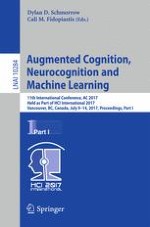2017 | OriginalPaper | Buchkapitel
Rim-to-Rim Wearables at the Canyon for Health (R2R WATCH): Correlation of Clinical Markers of Stress with Physiological COTS Data
verfasst von : Lucie Jelinkova, Emily Pearce, Christopher Bossart, Risa Garcia, Jon Femling
Erschienen in: Augmented Cognition. Neurocognition and Machine Learning
Aktivieren Sie unsere intelligente Suche, um passende Fachinhalte oder Patente zu finden.
Wählen Sie Textabschnitte aus um mit Künstlicher Intelligenz passenden Patente zu finden. powered by
Markieren Sie Textabschnitte, um KI-gestützt weitere passende Inhalte zu finden. powered by
